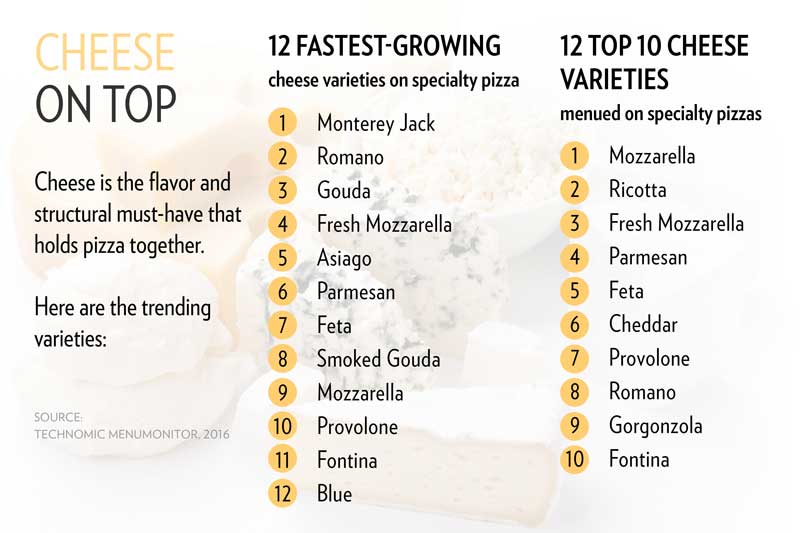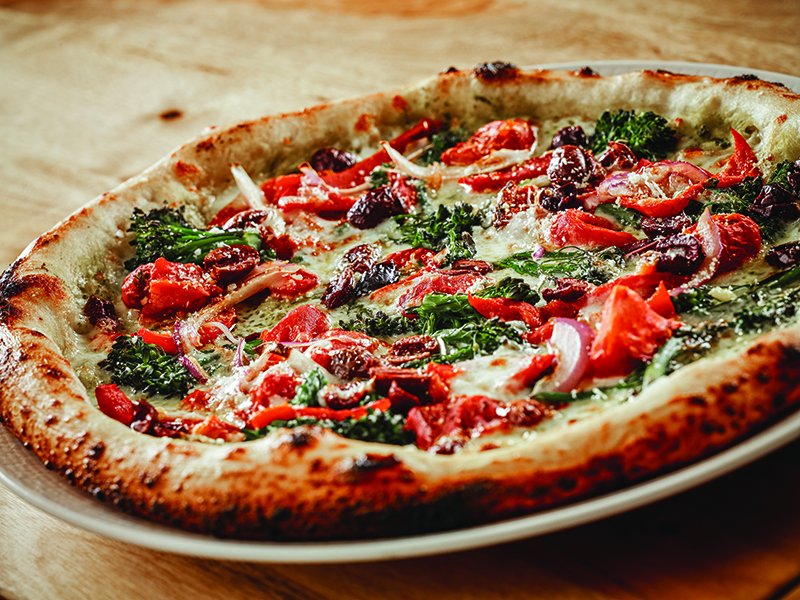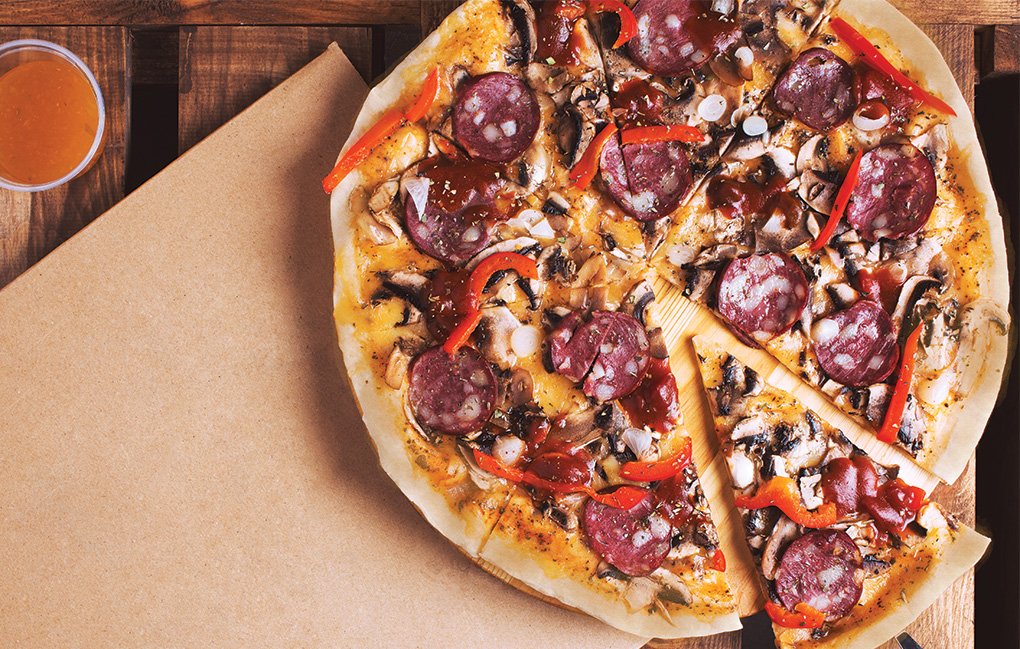Homemade pico de gallo, mozzarella, spicy lime chicken breast, red onion, sliced avocado, sour cream, green onions and fresh cilantro. Jalapeño pimento cheese, roasted red peppers and crumbled bacon, wood-fired and topped with fresh spinach leaves. Ricotta, pancetta, arugula and a poached egg.
These pies, from Zpizza, Brixx Wood Fired Pizza and Hearthstone Kitchen & Cellar, respectively, are more representative of where the pizza business is going these days. Diner sophistication is certainly a factor here, but pushing pizza innovation forward at lightning speed is the fast-casual pizza segment.
Concepts like Blaze Pizza, Pie Five Pizza Co. and Mod Pizza showcase a dizzying array of toppings, giving consumers the keys to endless flavor combinations. They’re setting expectations, making feta, fresh-chopped rosemary and balsamic-fig reductions a familiar part of pizza builds.
Traditional tomato sauce now has competition from Buffalo-ranch, Sriracha marinara and Korean barbecue sauce.

“We don’t even have that many pies made with traditional pizza sauce,” says Richard Shinault, director of culinary operations for 35-unit Brixx, based in Charlotte, N.C. Menu items include the new Cubano Pizza, a whole-grain crust with a honey mustard base topped with all-natural, citrus-marinated pulled pork, prosciutto, mozzarella and Fontina cheese with diced pickles. There’s also the popular Pear & Gorgonzola, a white pie with sliced pear, mozzarella, Gorgonzola and caramelized onions, finished with toasted walnuts. In fact, only four pies start with tomato sauce.
“The kids can have the pepperoni,” says Shinault, noting that parents go for specialties like Brixx’s handcrafted pizza with wild mushrooms and arugula. Pizza here generally captures 55 to 60 percent of sales, depending on location. A 24-tap craft-beer selection, 16 wines by the glass and a large selection of inviting starters, salads, sandwiches and pastas also help keep the competition at bay.
Consumers are holding all restaurants to a higher standard, not just pizzerias, says Shinault, with more demand for scratch-made quality and eclectic toppings. Having come from a fine-dining background, he applies the same R&D thought process to pizza, which results in sophisticated flavor and ingredient combinations. It still surprises him how passionate guests can be about their favorite Brixx pies, and success of any one recipe is not judged so much by its sales volume as by the vocal nature of those passions. “Our niche pies are just as important as our top-sellers.
Creativity is Key
Innovation is a regular part of modern menu development. The Bourbon Pizza, for example, was introduced on the winter menu. “The bourbon glaze has been around for a long time, but it’s new on pizza,” says Shinault, who often gets ideas from the field when an individual unit finds success with a daily special. “As long as they’re doing the core menu, we encourage the chefs and kitchen managers to experiment based on the local market. There’s lots of knowledge out there that we can tap.”
Customer feedback is also important, and it’s only solicited after a pie has been eaten. “We don’t tell guests ahead of time that they’ve just ordered a test pizza, so that they don’t have preconceived notions,” he says. And, since the chef is also the purchasing manager, Shinault has a good handle on the costs throughout the development process. “We let the tasting and feedback win, and then we discuss the pricing,” he says. “It really speeds the process and supports our quality standards when we don’t have to keep compromising on the ingredients.”
Pizza as a blank canvas
“Think of pizza as a blank canvas that you can do just about anything with,” suggests Bradford Kent, executive chef of Pasadena, Calif.-based Blaze Pizza, a leader among the new breed of fast-casual, customized-pizza specialists that have been pushing growth in the pizza segment in recent years. In fact, that approach is one of the key factors that allows Blaze, with more than 150 units, to be marketed as a “share-your-creation” experience, says Kent.
“If you come in to Blaze with five other people and you all share the pies you’ve created, you have six different flavor experiences at one time. That’s really what we offer.” Kent notes that with 10 different bases (from classic red sauce to garlic pesto sauce, as well as “drizzles” meant to add a finishing boost of flavor) and more than 30 meat, vegetable and cheese toppings, customers can get quite creative.
Despite the infinite number of combinations, though, Kent doesn’t see that many bombs among the guest-created pies, which capture about half of overall pizza orders, versus the house-curated Signature Pizzas. “Most of our customers really do understand what goes with what,” he says, adding that it’s even possible to create an ethnic pie (such as a gyro-like Greek pizza with crumbled meatballs, feta and olives) with enough understanding of the flavor and ingredient principles at work.
“Pizzas are like open-faced sandwiches in the way they’re built,” says Kent, who admits to being more of a sandwich guy than a pizza lover. But in his opinion, the critical element of the pizza experience—the ingredient that must be there—is cheese. This is a lesson he learned at Olio Wood Fired Pizzeria, the more upscale antecedent of Blaze that still serves as a testing ground of sorts for its younger sibling. “We played around with one there that was topped with duck-fat fries, Kobe tartare and wasabi. Great flavors together, but when you tried to add cheese, not so much. And if it doesn’t work with cheese, it’s not a pizza—it’s just bread with stuff on it.”
Not surprisingly, guest creations and customer requests are often the inspiration for new menu innovations—especially given the current anything-goes approach to pizza. Other times, LTOs and daily specials at the unit level make their way onto the regular menu.

Decades ago, Wolfgang Puck pioneered the innovative gourmet approach to pizza. His concepts continue pushing that innovation today.
Pizza Pushing Boundaries
“Consumer taste is getting more adventurous and more open to trying new things, and that drives us to continually improve,” says Joe Essa, president, Wolfgang Puck Worldwide, based in Beverly Hills, Calif. “Our customers have given us a lot of latitude to be creative.”
With responsibility for Puck’s casual-dining empire, Essa presides over some 40 restaurants representing such concepts as Wolfgang Puck Bistros and Cafés, Wolfgang Puck Express, WP Kitchen + Bar and The Kitchen by Wolfgang Puck—all but five of which provide some form of the celebrity chef’s trend-setting gourmet pizza. “With Wolf’s name on the door, our customers expect something a little different when it comes to pizza,” says Essa.
Depending upon the market, season or circumstances, pizzas might be topped with anything from duck or lamb sausage to an interesting blend of five cheeses with arugula or even kale, says Essa.
Each unit is required to have three to four standards on the menu, including a classic Margherita, a mushroom-topped pie of some sort (such as the Express’ Roasted Mushroom with garlic cream, goat cheese, arugula and Parmesan), and a variation on the barbecue chicken pie inspired by the California-style pizzas Puck first served at Spago more than 30 years ago.
“Beyond that, the kitchen in each restaurant is free to play around with three or four additional pies based on what’s available seasonally in the location,” Essa says.
That level of menu innovation is important for the Puck concepts, especially with their front-and-center exhibition kitchens, which celebrate the craft of pizza-making. Explains Essa: “It’s part of our hospitality for guests to be able to see and smell their pizzas being made.”
Pizzas from LTOs
Many of the pies on the menu at Pizza Factory, based in Oakhurst, Calif., spring from LTOs and specials in individual units, says president and chief executive Mary Jane Riva, a former franchisee who, along with her husband, bought the 100-plus-unit chain from its founders in 2012.
With its market focus on smaller towns like Payson, Ariz., and Fresno, Calif., Pizza Factory aims to be part of each community with programs like an anti-bullying initiative and a robust focus on local marketing.
The couple bought the chain to update branding and systems, not the food, necessarily, which Riva says has always been “amazing.” But the community’s flavor preferences do influence the menu. This starts with the mandatory Factory Special, a combo pie that can be named after the local high school sports team or anything else with community appeal. (In Payson, the Rim Combo pays tribute to the proximity of the Grand Canyon, while the original Oakhurst, Calif., unit that Riva operates features the Big D Special in honor of the football team.)
Franchisees are able to make any “blackboard” pie as long as the ingredients are already in house—and with pastas, sandwiches, calzones and salads on the menu, there do tend to be a lot of SKUs.
There are also biannual LTOs chosen by the franchisee-based marketing team, and pies being piloted in test stores—such as a Buffalo Chicken Pizza that cross-utilizes ingredients with a sandwich and a salad, and a simple fresh mozzarella, olive oil, and fresh tomato pie. But inspiration can even come from pizzas that employees might make for staff meal.
In this way, pies like the Pesto, Sun-dried Tomatoes & Garlic, various seafood-based pies, and local specialties like Fajita Chicken have come into existence. “You’d be surprised what ingredients go together when the employees are playing around in the kitchen with different combinations,” says Riva.
Gluten-Free Pizza Crust
It’s a measure of the times that so many restaurants that serve pizza offer the option of a gluten-free crust.
“Adding a gluten-free crust has been a big, big success story for us, especially when you look at the big picture,” says Richard Shinault, director of culinary operations for 35-unit Brixx Wood Fired Pizza “We sell about 100,000 a year as a system, but since the person with the gluten sensitivity usually chooses where to eat, that drives 300,000 items sold overall.”
Brixx added the items four years ago in response to demand, bringing in a prepared product (whereas the regular crust is made in house). Special steps also needed to be taken to meet the gluten-free requirements. “We purchased specific, separate pans for gluten-free pizzas so there would be no errors, and we take special care with storage.”
“You do have to be very, very cautious about all your ingredients,” says Bradford Kent, executive chef of Blaze Pizza, which also offers a gluten-free crust as well as a “High-Rise Dough” option in which extra dough is added to the pan to make a thicker crust (for an additional charge). “Today’s customers are incredibly aware of what’s in their food, from the point of view of both nutrition and social consciousness.”
The inquiries he gets from guests, especially from those who are avoiding gluten or meat, indicate tremendous interest in “going clean,” as Kent describe it: “No GMOs, no stabilizers, no artificial ingredients. So I’m always on the lookout for cleaner-label ingredients.” He adds that Blaze is turning away from bleached flour in its pizza dough, which is made fresh in house.
“We use all-natural flour in our dough now, and it undergoes a 24-hour fermentation process,” he explains. “We don’t really tout this, but it’s one of the reasons why our pizza tastes so much better.”
Pizza, by Any Other Name
Pizzas don’t even necessarily need to be called pizzas, and there is certainly no shortage of global precedent for the trend, including Middle Eastern flatbreads and even Provençale-style pissaladière. That’s how the savory puff pastry tart appears on the menu at Avenue, located beachfront at Pier Village in Long Branch, N.J.
“There are pizza places on every corner, especially in New Jersey,” says Executive Chef Joshua Sauer, who introduced the item four years ago. “I wanted something different, but equally appealing.” The flatbread-like tart of caramelized onions and goat cheese fits in with the rest of the menu concept—which is styled as classic-Parisian-brasserie-meets-Saint-Tropez—with lots of fresh fish and other lighter fare.
The key to the tart is the onions, which cook slowly in extra-virgin olive oil for hours until they are rich, soft and sweet—no salt, which breaks up the onions too much. The pan is then deglazed with sherry vinegar for a balance of acid. Meanwhile, the puff pastry shells are cooked under a weight to render them thin and crunchy. This step also makes them sog-proof when the pissaladière is assembled to order with the onions, popped back into the oven for a few minutes, then topped with lots of fresh thyme, soft ashen goat cheese, white anchovies and salty Niçoise olives.
In the height of summer, a similar menu item is topped with fresh Jersey tomatoes, both sliced and concasse, with a finish of micro basil, like a very refined Margherita.
Like a pizza, the tarts can be handheld and easily shared, but Sauer says that first-timers don’t necessarily get the connection. “The servers need to sell it a bit,” says the chef, who provides a glossary of menu terms and conducts training with samplings for the front-of-the-house staff. “But people come in especially for this, and it’s become a real signature for us.”










